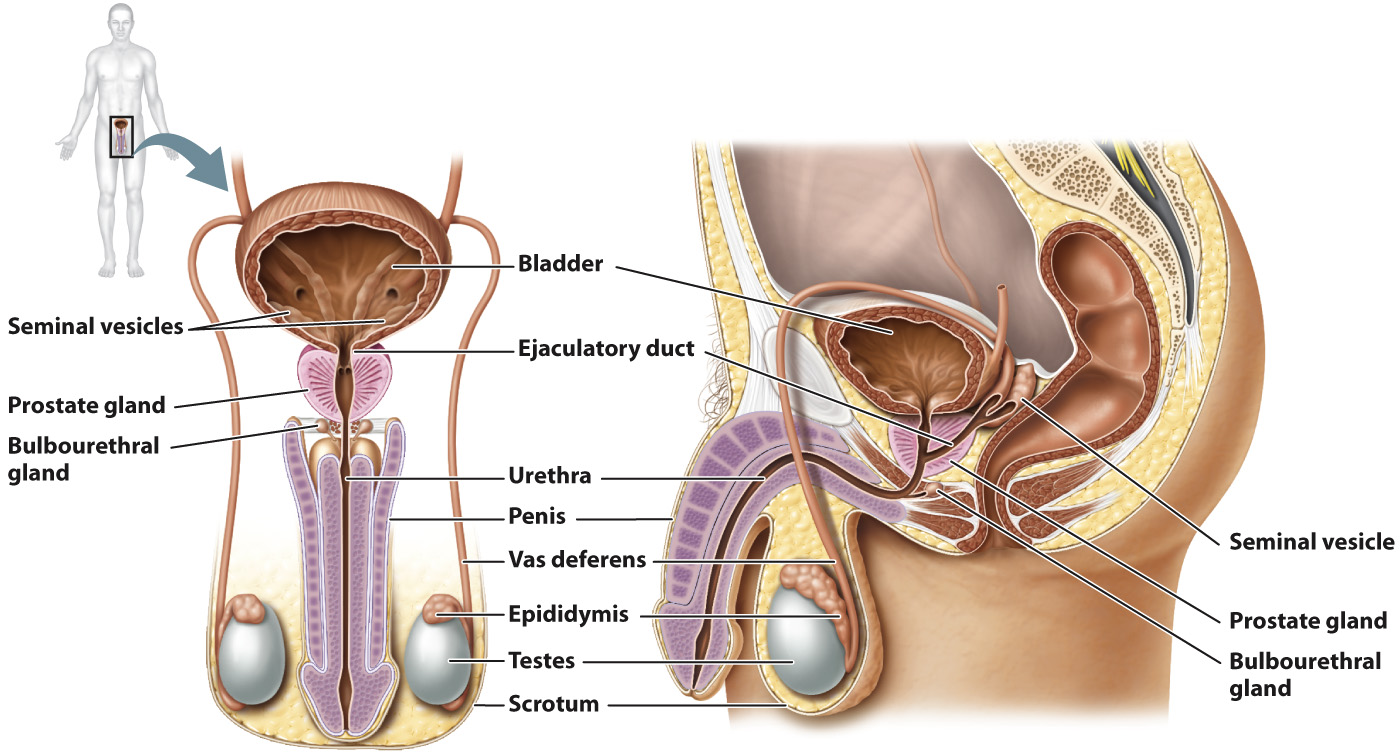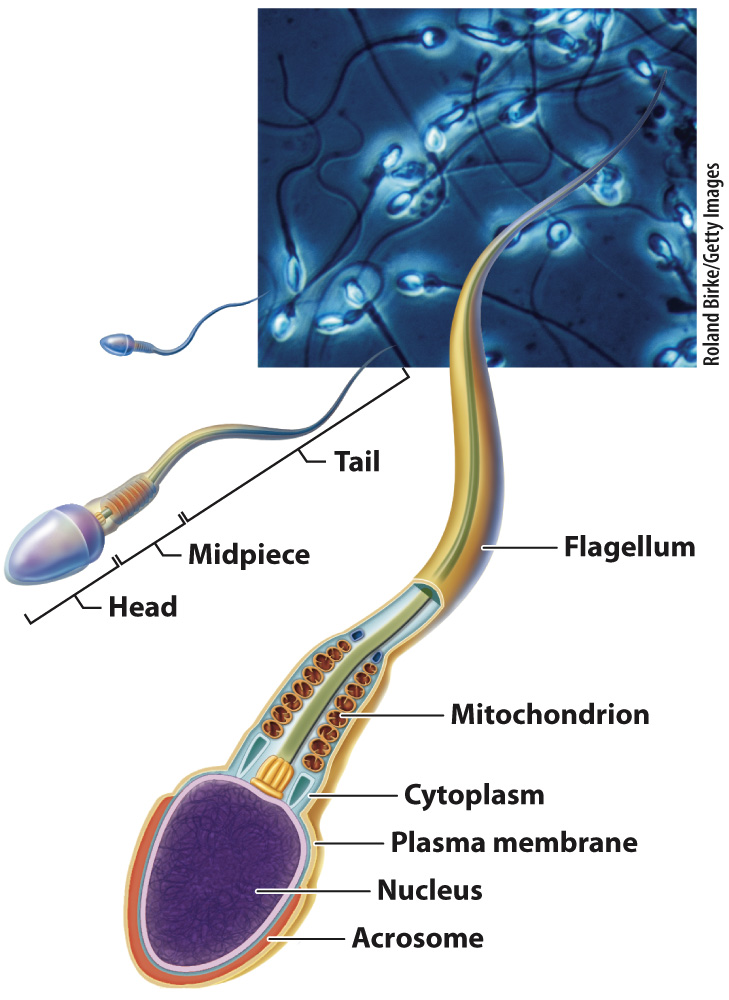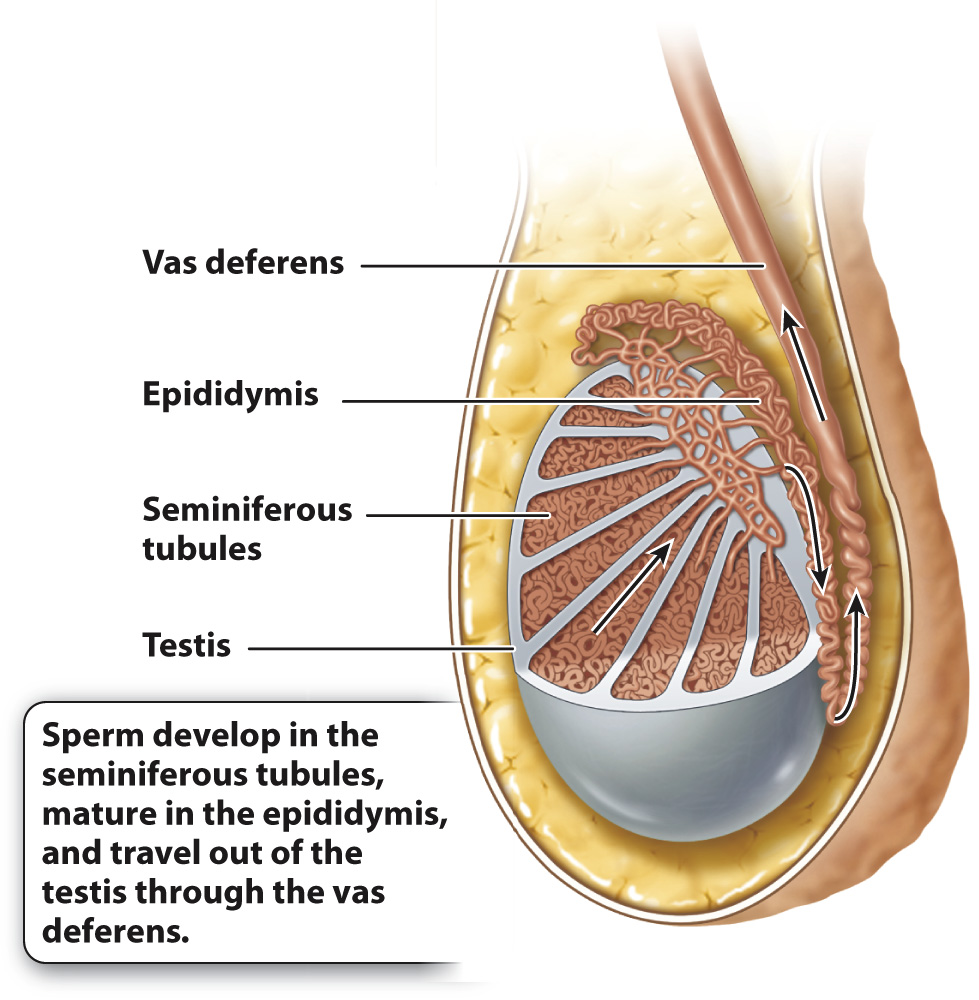The male reproductive system is specialized for the production and delivery of sperm.
Let’s start by considering the human male reproductive system. Male gametes, called spermatozoa or sperm, are produced in the two male gonads, or testes (singular, testis; Fig. 42.11). Over the course of his life, a man is capable of making hundreds of billions of sperm. In fact, a single ejaculate typically contains several hundred million sperm. If it takes just one sperm to fertilize an egg, why do males make so many? A likely explanation involves sperm competition. In species like humans, where females can mate with more than one male, a male’s reproductive success is at least partially correlated with the number of sperm—
906


Sperm are haploid cells with a unique shape and properties adapted for their function of delivering genetic material to the egg (Fig. 42.12). They have a small head containing minimal cytoplasm and a very densely packed nucleus. The head is surrounded by a specialized organelle, the acrosome, which contains enzymes that enable the sperm to transverse the outer coating of the egg. Sperm have a long tail, or flagellum, which moves the cell by a whipping motion powered by the sperm’s mitochondria.
The testes are located outside the abdominal cavity in a sac called the scrotum (see Fig. 42.11). This location is critical for the production of sperm, which require cooler temperatures than are found in the abdominal cavity of humans. However, the testes of some mammals, such as elephants, whales, and bats, are located inside the abdominal cavity, indicating that there are species-
Sperm are produced within the testes in a series of tubes called the seminiferous (“seed-
From the seminiferous tubules, sperm travel to the epididymis, where they become motile (Fig. 42.13). This is also where sperm are stored prior to ejaculation. From there, sperm enter the vas deferens, a long, muscular tube that follows a circuitous path, starting off in the scrotum of each testis, passing into the abdominal cavity, running along the bladder, and then connecting with an ejaculatory duct (see Fig. 42.11). The two ejaculatory ducts merge at the urethra, just below the bladder. The urethra is used by both the urinary and reproductive systems in males.

Along this path, there are several exocrine glands that produce components of semen, the fluid that nourishes and sustains sperm as they travel in the male and then female reproductive tracts. The first is the prostate gland, located just beneath the bladder (see Fig. 42.11). The urethra and ejaculatory ducts pass directly through this gland. The prostate gland produces a thin, slightly alkaline fluid that helps maintain sperm motility and counteracts the acidity of the female reproductive tract. Two seminal vesicles, located at the junction of the vas deferens and the prostate gland, secrete a protein-
The urethra is enclosed in the penis, the male copulatory organ (see Fig. 42.11). When a male is sexually aroused, the penis becomes erect as a result of changes in blood flow—
The male reproductive system is well adapted for the production, storage, and delivery of sperm. Therefore, male contraceptive methods focus on blocking sperm. For example, a condom is a sheath of rubber or latex that covers the penis and prevents sperm from entering the female during sexual intercourse.
907
The human penis is a relatively simple organ, consisting of a shaft and a head called the glans penis. In other animals, the penis can be quite elaborate, with spikes, hooks, and grooves whose functions are to stimulate the female, grip the female, and in some cases even remove sperm from a previous copulation. In marsupial mammals like kangaroos and koalas, males have forked penises, and in snakes and lizards, males have two penises, called hemipenes. In insects, the external genitalia are often distinct enough to be used in species identification. By contrast, most species of birds do not have a penis.
Quick Check 2 What effect would cutting the vas deferens on both sides and tying off the ends have on male fertility?
Quick Check 2 Answer
The vas deferens carries sperm from the epididymis to the ejaculatory duct. Cutting the vas deferens on both sides prevents sperm from entering the ejaculatory duct and leads to male sterility. This procedure, called a vasectomy, is a method of male contraception.